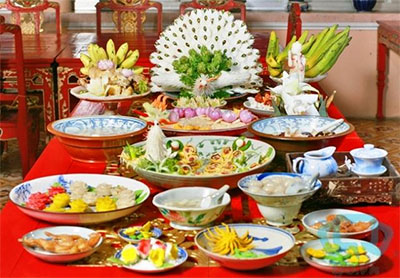Coming to the ancient capital city, visitors can admire the beauty of the system of royal tombs of the Nguyen Dynasty, and also enjoy the unique culinary and cultural history of this land.
 |
|
Hue cuisine artisan Ton Nu Thi Ha. |
Where the sky and earth are in harmony
According to researchers, Viet Nam has about 3,000 different kinds of dishes, of which Hue accounts for over 1,700.
Hue - the center of Dang Trong region under the Nguyen Lords – was the capital city in the 19th century. That required Hue people to not only be good at cooking rustic foods but also know how to prepare exquisite cuisine for the royal government.
Today, though it is no longer an economic-political center of the country, Hue still maintains the shadow of an ancient dynasty with a golden age. And among the characteristics of Hue’s ancient culture, food has helped shape the culture and style of Hue.
Hue cuisine is increasingly enriched by topography. For example, the Hen islet amid the Huong River is usually flooded during the rainy season and is the home to sweet corns and mussels, which are the materials needed to process many delicious dishes.
The sea of Thuan An and the Tam Giang-Cau Hai lagoon with brackish water supplies the best seafood in Southeast Asia including shrimp, crab, fish, squid ...
Royal food
Hue Royal Cuisine has many rules and etiquette from food supply to the processing techniques, service, and the types of trays, tables, plates and bowls. The King’s eating is called “ngu thien”, the kitchen tools for the King are called “ngu dung”. The chefs who cook for the King are called the “Thuong Thien” team.
King Gia Long was the most simple in eating while King Dong Khanh was picky. Each meal for the king included 50 different dishes processed by 50 chefs. The old historical book Dai Nam Thuc Luc Chien Bien wrote that the King had 12 dishes for breakfast, and 50 savory and 16 sweet dishes for lunch and dinner, including several of the eight precious dishes.
Cultural researcher Ho Tan Phan said that stemming from the perception of bringing the world to serve the heaven’s son (King), each meal of Nguyen kings had over 50 different dishes although the King ate very little. The food was mainly used as the king’s favors for mandarins.
The royal cuisine of Hue is not only the art of processing and presentation of the food but the philosophical concept and the aesthetic ideas of enjoying food. Besides beautifully and harmoniously arrangements, each meal for the king was structured in a scientific way: vegetables going with meat; dishes chosen based on the weather; and spices fitting naturally.
 |
|
Hue royal cuisine. |
Honoring Vietnamese culture
According to artisan Ton Nu Thi Ha, an expert of Nguyen royal cuisine, Hue royal cuisine mainly served the king so it had very strict criteria. The dishes are not only processed in a sophisticated way but also have to show the ideas of Hue people: the food is enjoyed with all the senses. The dishes must be harmonious in terms of color, taste and also yin-yang, hot - cold, and the layout of the dinner set. That’s the natural harmony and culture of Hue.
“Cooking is a hard job, but through this profession I have many opportunities to interact with the world outside. Through food, I have the opportunity to introduce international friends the beauty of Vietnam culinary arts. However, the preservation of Hue cuisine and development of culinary services in Hue is still an unsolved problem,” said artisan Ha.